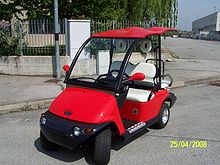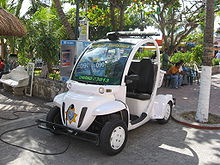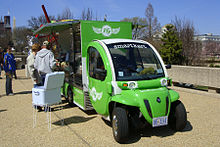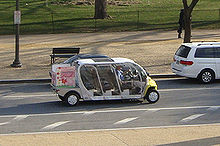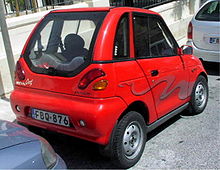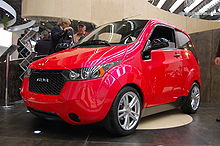- Neighborhood Electric Vehicle
-
A Neighborhood Electric Vehicle (NEV) is a U.S. denomination for battery electric vehicles that are legally limited to roads with posted speed limits as high as 45 miles per hour (72 km/h) depending on the particular laws of the state, usually are built to have a top speed of 30 miles per hour (48 km/h), and have a maximum loaded weight of 3,000 lbs.[1] NEVs fall under the United States Department of Transportation classification for low-speed vehicles.[2]
A NEV battery pack recharges by plugging into a standard outlet and because it is an all-electric vehicle it does not produce tailpipe emissions. If recharged from clean energy sources such as solar or wind power, NEVs do not emit greenhouse gas emissions. In the state of California NEVs are classified by the California Air Resources Board (CARB) as zero emissions vehicles (ZEV) and are eligible for a purchase rebate of up to $1,500 if purchased or leased on or after March 15, 2010.[3][4]
Contents
U.S. regulations
Low-speed vehicle is a federally approved street-legal vehicle classification which came into existence in 1998 under Federal Motor Vehicle Safety Standard 500 (FMVSS 500). There is nothing in the federal regulations specifically pertaining to the powertrain.
Low-speed vehicles are defined as a four-wheeled motor vehicle that has a gross vehicle weight rating of less than 3,000 pounds (1,400 kg) and a top speed of between 20 to 25 mph (32 to 40 km/h).[5] Those states that authorize NEVs generally restrict their operation to streets with a maximum speed limit of 35 or 45 mph (56 or 72 km/h). Because of federal law, car dealers cannot legally sell the vehicles to go faster than 25 mph (40 km/h), but the buyer can easily modify the car to go 35 mph (56 km/h). However, if modified to exceed 25 mph (40 km/h), the vehicle then becomes subject to safety requirements of passenger cars.[citation needed]
These speed restrictions, combined with a typical driving range of 30 miles (48 km) per charge and a typical three-year battery durability, are required because of a lack of federally mandated safety equipment and features which NEVs can not accommodate because of their design. To satisfy federal safety requirements for manufacturers, NEVs must be equipped with three-point seat belts or a lap belt,windshield wipers are not required, running lights, headlights, brake lights, reflectors, rear view mirrors, and turn signals. In many cases, doors may be optional, crash protection from other vehicles is partially met compared to other non motorized transport such as bicycles because of the use of seat belts.
State regulations
Regulations for operating an NEV vary by state. The federal government allows state and local governments to add additional safety requirements beyond those of Title 49 Part 571.500. For instance,the State of New York requires additional safety equipment to include windshield wipers, window defroster, speedometer, odometer and a back-up light. Generally, they must be titled and registered, and the driver must be licensed. Because airbags are not required the NEV cannot normally travel on highways or freeways. NEVs in many states are restricted to roads with a speed limit of 35 mph (56 km/h) or less.
Community design
Some communities are designed to separate neighborhoods from commercial and other areas, connecting them with relatively high speed thoroughfares on which NEVs cannot go, legally or safely. As a result, these vehicles are most common in communities that provide separate routes for them or generally accommodate slow speed traffic.
Some communities designed specifically with NEVs in mind include:
Other communities that permit NEVs:
- Put-in-Bay, Ohio
- Playa Vista, Los Angeles, California
- Lincoln, California
- Coronado, California[6]
- Leaf Rapids, Manitoba, Canada[7]
Sales
In January of 2009 the U.S. Army has announced that it will lease 4,000 Neighborhood Electric Vehicles (NEVs) within three years. The Army plans to use NEVs at its bases for transport of personnel and for security patrols and maintenance and delivery services.[8]
Examples
- BugE
- Columbia ParCar Summit LSV [9]
- CT&T
- Global Electric Motorcars (GEM)
- The Kurrent
- Miles Automotive Group
- MIT Car
- Mycar
- Oka NEV ZEV
- Personal Urban Mobility and Accessibility (proposed)
- Polaris Ranger EV LSV [10]
- REVA
- Solar Bug (Free Drive EV)
- T3 Motion, Inc.
- Xtreme Green Products [11]
- ZENN (Feel Good Cars)
See also
- Electric Commercial Vehicles
References
- ^ "What is a neighborhood electric vehicle (NEV)?". AutoblogGreen. 2009-02-06. http://green.autoblog.com/2009/02/06/greenlings-what-is-a-neighborhood-electric-vehicle-nev/. Retrieved 2010-06-09.
- ^ "US DEPARTMENT OF TRANSPORTATION National Highway Traffic Safety Administration 49 CFR Part 571 Federal Motor Vehicle Safety Standards". http://www.nhtsa.dot.gov/cars/rules/rulings/lsv/lsv.html. Retrieved 2009-08-06.
- ^ "CVRP Eligible Vehicles". Center for Sustainable Energy California. http://energycenter.org/index.php/incentive-programs/clean-vehicle-rebate-project/cvrp-eligible-vehicles. Retrieved 2010-06-08.
- ^ "Clean Vehicle Rebate Project". Center for Sustainable Energy. http://energycenter.org/index.php/incentive-programs/clean-vehicle-rebate-project. Retrieved 2010-04-01.
- ^ 49 CFR § 571.3 - US Code of Federal Regulations; [1]
- ^ Zúñiga, Janine (2007-05-29). "Coronado's electric cars enjoying life in the fast lane". San Diego Union-Tribune. http://www.signonsandiego.com/uniontrib/20070529/news_1n29ecars.html. Retrieved 2007-08-24.
- ^ Young, Kathryn (2007-08-23). "Town that banned bags touts golf carts". Times Colonist. http://www.canada.com/victoriatimescolonist/news/story.html?id=148eb4fd-8dde-459f-9c89-b4f5fb808868&k=67960. Retrieved 2007-08-24.
- ^ "Army announces historic electric vehicle lease". Army.mil. 2009-01-20. http://www.army.mil/-newsreleases/2009/01/12/15707-army-announces-historic-electric-vehicle-lease/. Retrieved 2010-11-27.
- ^ "Columbia ParCar Corp. - Summit - | SM2 | SM4 |". Parcar.com. http://www.parcar.com/ngp/!stmenu_template.main?complex_id_in=270.52560.52560.52707.cat. Retrieved 2010-11-27.
- ^ "2011 Polaris RANGER EV Electric UTV : Overview". Polarisindustries.com. http://www.polarisindustries.com/en-us/atv-ranger/2011/mid-size-utility-vehicles/ranger-ev/pages/overview.aspx. Retrieved 2010-11-27.
- ^ {{cite web|url=http://www.xgpinc.com]
External links
- The ZENN (Zero Emissions No Noise) of Driving
- S.A.V.E. pushes legislation for 35 mph in Montana.
- Yahoo! NEVs group
- Summary of Montana's Medium-Speed Electric Vehicle (MSEV) legislation
- Washington's MSEV legislation
Alternative fuel vehicles Compressed-air engine Electric motor Battery electric vehicle · Electric aircraft · Electric bicycle · Electric boat · Electric car · Electric vehicle · Electric motorcycles and scooters · Hybrid electric vehicle · Motorized bicycle · Neighborhood Electric Vehicle · Plug-in electric vehicle · Plug-in hybrid electric vehicle · Solar vehicle · Wind-powered vehicleBiofuel ICE Hydrogen Fuel cell vehicle · Hydrogen economy · Hydrogen vehicle · Hydrogen internal combustion engine vehicleOthers Autogas · Hybrid electric vehicle · Liquid nitrogen vehicle · Natural gas vehicle · Propane · Steam car · Wood gasMultiple-fuel Documentaries See also Categories:- Battery electric vehicles
- Neighborhood electric vehicles
Wikimedia Foundation. 2010.


